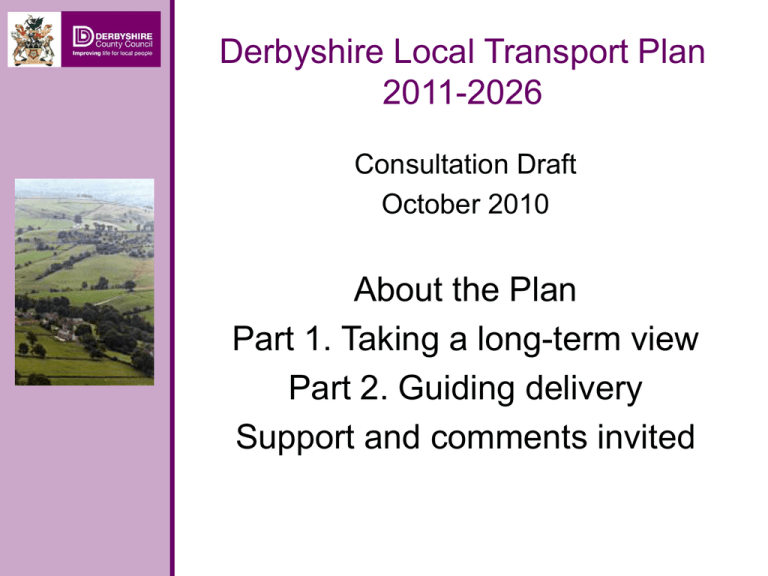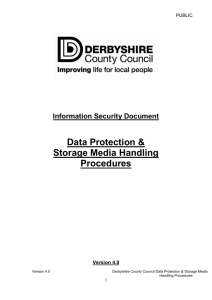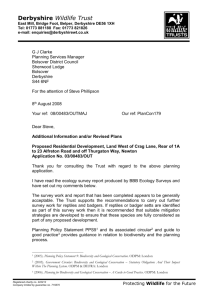Slide 1 - Derbyshire County Council
advertisement

Derbyshire Local Transport Plan 2011-2026 Consultation Draft October 2010 About the Plan Part 1. Taking a long-term view Part 2. Guiding delivery Support and comments invited Derbyshire Local Transport Plan 2011-2026 About the Plan The Local Transport Plan covers Derbyshire County Council’s area, and the County Council is working with partners on cross-boundary issues. The local transport network includes roads, pavements, rights of way and greenways, rail and canal networks, so this includes consideration of, for example, pedestrians and cyclists as well as motorised traffic. Taking a long-term view (to 2026), the Local Transport Plan contains policies for the promotion and encouragement of safe, integrated, efficient, sustainable and economic transport. It also explains how we will deliver the policies. Derbyshire’s central position in the country, surrounded by major centres of population, yet containing a large proportion of the Peak District National Park, presents a unique set of transport challenges which the Plan needs to address. Derbyshire Local Transport Plan 2011-2026 Part 1: Taking a long-term view “Good transport is a vital factor in building sustainable communities. It contributes to the achievement of safer and stronger communities, healthier children and young people, equality and social inclusion, environmental objectives and better local economies.” Department for Transport Guidance 2009 Following national guidance, the long-term strategy started with identifying a set of challenges for Derbyshire in relation to achieving high level transport goals. Derbyshire Local Transport Plan 2011-2026 Part 1: Taking a long-term view - goals Our Plan’s high level goals are: • • • • • Supporting a resilient local economy. Tackling climate change. Contributing to better safety, security and health. Promoting equality of opportunity. Improving quality of life and promoting a healthy natural environment. Challenges were identified using a wide range of evidence – local data and analysis, local consultation and a policy review. Derbyshire Local Transport Plan 2011-2026 Part 1: Taking a long-term view - challenges Examples of the transport challenges for supporting a resilient local economy are: • • • • • • • A reliable transport infrastructure linked to policies and plans to promote sustainable economic growth. Rural transport – to support local business and access to services and employment for residents and visitors. Business and commuting journeys – to improve reliability and connectivity on key routes. Tackling congestion. Supporting sustainable tourism and leisure. Supporting the delivery of housing and new development. Enhancing resilience – e.g. to adverse weather, collisions and the impacts of climate change. Derbyshire Local Transport Plan 2011-2026 Part 1: Taking a long-term view - challenges Examples of the transport challenges for tackling climate change are: • • • • • • Reducing greenhouse gas emissions through new technologies and cleaner fuels, energy efficiency, and encouraging ‘smarter choices’ of car sharing, using public transport, walking and cycling. Predicting and coping with the potential disruption of extreme weather events to the transport network. Achieving lower carbon commuting for all. Assessing flood risk in Derbyshire and ensuring that the risk of flooding does not increase. Maintaining vegetation which has a longer growing season. Event management to reduce private car use. Derbyshire Local Transport Plan 2011-2026 Part 1: Taking a long-term view - challenges Examples of the transport challenges for equality of opportunity are: • • • • • • • A growing number of older people. Providing transport and services for disadvantaged groups, such as unemployed or disabled people. Providing a network of transport services including public transport, subsidised services and alternative transport arrangements. Supporting valuable non-public transport initiatives such as volunteer car schemes, community transport and wheels to work. Providing information on all transport options. Providing fully accessible public transport. Providing highway infrastructure to assist vulnerable users. Derbyshire Local Transport Plan 2011-2026 Part 1: Taking a long-term view - challenges Examples of the transport challenges for safety, security and health are: • • • • • • • Reducing the risk of death or injury – a danger reduction approach so that it’s safer to walk, cycle and horse ride. Achieving value for money in road engineering schemes. Effective targeting and monitoring – current priorities are reducing vulnerable road user casualties, reducing motorcyclist casualties, managing occupational road risk, tackling problem routes and reducing young driver casualties. Reducing crime, fear of crime and anti-social behaviour on transport networks. Street lighting improvements. Encouraging ‘active travel’ – walking and cycling. Improving public health. Derbyshire Local Transport Plan 2011-2026 Part 1: Taking a long-term view - challenges Examples of the transport challenges for quality of life and a healthy natural environment are: • • • • • • • Protecting sense of place and the natural and historic environment. Reducing air pollution. Improving streetscapes and the urban environment. Creating opportunities for social contact and access to leisure and the countryside. Reducing sign clutter. Enhancement of green infrastructure – e.g. road verge reserves and better connected traffic-free routes. Good design and material usage. Derbyshire Local Transport Plan 2011-2026 Part 1: Taking a long-term view - challenges The full set of identified challenges can be found in the draft Plan. “These challenges will drive the development and delivery of the Local Transport Plan.” Department for Transport Guidance 2009 Derbyshire Local Transport Plan 2011-2026 Part 1: Taking a long-term view – strategic options 2011-2026 As part of a Strategic Environmental Assessment (SEA) process, required by European law, the County Council devised a number of reasonable strategic options in developing the Plan. A ‘Local Transport Futures: Challenges and Options consultation’ was carried out in early summer 2010. The results of this survey, combined with an assessment of the options against the SEA objectives, has helped the County Council to develop its preferred strategy: Derbyshire Local Transport Plan 2011-2026 Part 1: Taking a long-term view – strategic options 2011-2026 The preferred strategy is to put emphasis on: • supporting a resilient local economy • contributing to better safety, security and health; and • improving quality of life and promoting a healthy natural environment. The preferred strategy will also aim to achieve longer term benefits for climate change, and measures to help people under the equality of opportunity goal. More information about the SEA can be found in the Environmental Report and the non-technical summary which accompany the draft Plan. Derbyshire Local Transport Plan 2011-2026 Part 1: Taking a long-term view – the strategy This preparation has helped the County Council to define its priorities for transport investment over the years to come for its following transport roles: • • • • • Well maintained roads and rights of way. Efficient transport network management. Improving local accessibility and achieving healthier travel habits. Better safety and security. A considered approach to new infrastructure. The following strategy represents the ‘ideal’ approach for Derbyshire. In developing a more specific programme of measures, consideration will also need to be given to affordability, deliverability and risk. Derbyshire Local Transport Plan 2011-2026 Part 1: Taking a long-term view – the strategy Well maintained roads and rights of way – priorities for delivery • Targeting maintenance improvements to make efficient use of resources. • Improving public satisfaction with maintenance. • Improving understanding of expected levels of service. • Environmental improvements e.g. biodiversity. • Reducing disruption caused by climate change. • Carbon dioxide (CO2) reduction. Derbyshire Local Transport Plan 2011-2026 Part 1: Taking a long-term view – the strategy Efficient transport network management – priorities for delivery • Co-ordination of street works. • Reducing congestion and delays for all road users. • Incident management and emergency responses. • Efficient winter service. • Management of planned events. • On street parking, loading and waiting control. • Direction and tourist signing. • Environmental improvements. • Travel information. • Freight management. Derbyshire Local Transport Plan 2011-2026 Part 1: Taking a long-term view – the strategy Improving local accessibility and achieving healthier travel habits – priorities for delivery • • • • • • • • • • • • • • Public transport information. Community transport services. Community rail services. Personalised travel advice for disadvantaged people. Minimising disruption from public transport service cuts. Access to jobs and training. Home to school transport and Special Needs Transport. Rural accessibility. Travel planning and monitoring (business, schools and new developments). Personalised travel marketing to encourage more sustainable travel. Travel awareness initiatives. School Crossing Patrol Service. Sustainable tourism and leisure activity. Independent travel training. Derbyshire Local Transport Plan 2011-2026 Part 1: Taking a long-term view – the strategy Better safety and security – priorities for delivery • Reducing vulnerable road user casualties (children, pedestrians and pedal cyclists). • Reducing motorcyclist casualties. • Managing occupational road risk. • Tackling problem routes. • Young drivers’ road safety awareness. • Improving public transport waiting areas. • Street lighting improvements. Derbyshire Local Transport Plan 2011-2026 Part 1: Taking a long-term view – the strategy A considered approach to new infrastructure – priorities for delivery • Infrastructure and services linked with new housing and other developments. • Walking and cycling provision. • Public transport provision. • Environmental mitigation measures. • Contribution to a strategic network of high quality green spaces. • Packages for improvement where there are air quality issues due to local traffic. • Liaison between spatial and transport planning on an ongoing basis. Derbyshire Local Transport Plan 2011-2026 There is current uncertainty about funding streams for major highway and transport projects. A list of potential major projects has been identified as follows: (alphabetical order) Potential Scheme Status A515 Ashbourne Bypass One of ‘priority’ schemes identified in preparation of second Local Transport Plan (LTP). A61-A617 ‘Avenue’ Link Road Identified through liaison over North-East Derbyshire Local Development Framework. A61 Chesterfield Inner Relief Road Junctions One of ‘priority’ schemes identified in preparation of second LTP. Gamesley Rail Station Under consideration as part of Longdendale Integrated Transport Strategy (led by Tameside Metropolitan Borough Council). A617 Glapwell Bypass One of ‘priority’ schemes identified in preparation of second LTP. Ilkeston Rail Station Development work approved by Cabinet, February 2010. A610 Ripley-Codnor- Woodlinkin Improvements One of ‘priority’ schemes identified in preparation of second LTP. A619 Staveley-Brimington Bypass Protected scheme ‘on hold’ pending the review of impacts of the Markham Vale development, and subject to consideration as part of the Staveley Area Action Plan. A514 Swarkestone Bypass Identified through liaison over South Derbyshire Local Development Framework. A511-A514 Woodville-Swadlincote Regeneration Route Identified through liaison over South Derbyshire Local Development Framework. Derbyshire Local Transport Plan 2011-2026 Part 1: Taking a long-term view – the strategy The draft Plan provides more information about the range of measures which can be used to achieve the priorities. These have been grouped into: Core business – work that is happening now on a routine basis e.g. maintenance of roads and bridges, junction improvements, school transport services, public transport information, school crossing patrol service and road safety education. Opportunities – new ideas, including special or temporary projects e.g. removing unnecessary infrastructure, personalised travel planning project and review of major schemes. Long-term projects – significant projects which should be explored in order for the County Council to achieve some of its longer term priorities e.g. multi-operator ticketing scheme, county wide network of greenways. Derbyshire Local Transport Plan 2011-2026 Programme management, monitoring and review The Local Transport Plan will be monitored, reviewed and refreshed on a regular basis. It is linked at a strategic level with joint plans e.g. the Sustainable Community Strategy, other plans of the Authority such as the Council Plan, and the plans of other organisations (e.g. spatial plans of the Districts/Boroughs – see Appendix B of the draft Plan). There are also more detailed transport-related plans which help deliver the County Council’s priorities e.g. the Transport Asset Management Plan, the Rights of Way Improvement Plan and Greenway Strategies. More information about these is provided in Appendix A of the draft Plan. Derbyshire Local Transport Plan 2011-2026 Derbyshire Transport Carbon Dioxide Reduction CO2 Strategy Transport policies and the carrying out of transport functions must take into account issues of climate change (Local Transport Act 2008). An important project has been an assessment of transport’s contribution to carbon dioxide (CO2) emissions in Derbyshire. The County Council needs to assess the best ways of investment to reduce carbon. In addition to making calculations for Derbyshire, the strategy has also assessed the predicted benefits from a range of things that can be done to reduce carbon emissions. This work has found that, in order to generate significant reductions in carbon emissions to support government targets, carbon reduction measures across the whole transport network are required, which represents a significant challenge (for key findings, recommendations and conclusion see Appendix C of the draft Plan). Derbyshire Local Transport Plan 2011-2026 Joint working arrangements A characteristic of Derbyshire is the number of adjoining authorities, and travel to work patterns go beyond administrative boundaries. The Sheffield City Region and Manchester City Region include parts of Derbyshire. The County Council is therefore involved in joint working arrangements with neighbouring authorities (see Appendix D of the draft Plan). Derbyshire Local Transport Plan 2011-2026 Derbyshire Transport Strategy summary of key messages The Plan must: • Take a longer term view. • Help support the local and sub-regional economy. • Mark a path towards more sustainable travel habits to reduce carbon dioxide (CO2) emissions and benefit personal and public health. • Consider the prospect of an ageing population profile for Derbyshire – with the number of people of retirement age set to increase by 25% over the next ten years. • Ensure that Derbyshire people who do not have access to a car (over 110,000 in the 2001 census, nearly 51,000 pensioners, and over 71,000 households) are able to access services and facilities. Following consultation, the preferred strategy is to put emphasis on supporting a resilient local economy, contributing to better safety, security and health, and improving quality of life and promoting a healthy natural environment. The preferred strategy will also aim to achieve longer term benefits for climate change, and measures to help people under the equality of opportunity goal. The Derbyshire Local Transport Plan will be reviewed on an ongoing basis. Derbyshire Local Transport Plan 2011-2026 Part 2: Delivery – next steps Sources of evidence The County Council’s priorities will be backed up by evidence to help decide the most effective way of allocating or seeking resources e.g.: Well maintained roads and rights of way Asset inventory, condition data, public surveys (Citizens Panel), public complaints, Local Access Forums, links to National Cycle Network Efficient transport network management Congestion data, public surveys, public complaints, Midlands Highway Alliance Improving local accessibility and achieving healthier travel habits Local Access Forums, Accession mapping, surveys (Job Centre, access to healthcare, Community Transport, Travel Plans), cycle counts, school census, car share database, rail user groups, cycle groups, transition towns, Equality Impact Assessments Better safety and security Casualty statistics, traffic speed data, public complaints, crime and antisocial behaviour intelligence, graffiti A considered approach to new infrastructure Asset Inventory, Local Economic Partnerships, Local Investment Plans, spatial planning, Environmental Assessment Derbyshire Local Transport Plan 2011-2026 Part 2: Delivery – next steps Funding our transport priorities The long-term transport strategy indicates our investment priorities. Resource will need to be drawn from a range of sources to deliver the priorities e.g. revenue and capital funds, developers, other local partners (e.g. District/Borough Councils and health sources), rail and bus operators, the voluntary and community sector, and taking opportunities to bid for funding pots such as lottery or European funding. At this stage, the County Council cannot be certain which package of measures can be funded until it knows more following the results of the national Comprehensive Spending Review in October. Derbyshire Local Transport Plan 2011-2026 Part 2: Delivery – next steps Funding our transport priorities The expected proportions of spend are as follows: Local Transport Investment 30% 50% Efficient maintenance and management Accessibility and healthy travel Better safety and security 20% The County Council also allocates resources to studies to help inform decisions about new infrastructure e.g. Chesterfield cycle network and Chesterfield transport model. Derbyshire Local Transport Plan 2011-2026 Part 2: Delivery – next steps Judging success Well maintained roads and rights of way • • • The condition of our non-principal roads has improved. Satisfaction with the condition of our highways improves. More of Derbyshire’s Rights of Way are free from obstruction and are easier to access by local people. Efficient transport network management • Congestion has reduced. Improving local accessibility and achieving healthier travel habits • • • • More people travel on Community Transport. Better facilities and networks for walking and cycling. Air quality has improved. More people are visiting our country parks and countryside centres. Better safety and security • • Fewer people are killed or injured on Derbyshire’s roads. Successful initiatives implemented to reduce crime/fear of crime. A considered approach to new infrastructure • • Reduce the number of assets. Informed by the Local Economic Partnerships so that transport infrastructure fits with plans for sub-regional economic development. Derbyshire Local Transport Plan 2011-2026 Guiding delivery - summary of key messages Successful delivery is dependent on working with a wide range of local partners, and cross-boundary project planning. With the financial constraints that the County Council knows lie ahead, it has to achieve value for money in all its work, yet it also needs to be opportunistic about new possibilities and identify long-term projects. Overall, the County Council is adopting a considered approach to infrastructure, whether small or larger projects. Because it cannot yet be specific about what will be happening where (i.e. until after the national announcements in autumn about funding), examples of the sources of evidence which will be used to guide action are described for each Derbyshire County Council transport role. The County Council has broadly identified projects to be pursued and what it hopes to achieve in five years. Derbyshire Local Transport Plan 2011-2026 Summary of what the County Council must achieve • • • • • • • • • Making the best use of what it’s got – maintenance and network management. Generating future transport infrastructure schemes at subregional level through the work of the Local Economic Partnerships. Safer roads. Consider new things – the framework of the strategy includes exploring new opportunities. Thinking long-term and planning ahead – e.g. implications of an ageing population. Improving customer satisfaction with transport services. Influencing others to change travel habits. Integration with land use planning. Continued adaptation of the strategy informed by partnership working, surveys and data analysis. Derbyshire Local Transport Plan 2011-2026 Support invited If you represent a local organisation or authority, the County Council would appreciate letters of support for the Plan if you wish to do so. Comments from all invited Please send any letters of support or comments on the draft plan by 17 January 2011 to: Integrated Transport Group Environmental Services Department Derbyshire County Council County Hall Matlock DE4 3AG e-mail: integratedtransport@derbyshire.gov.uk Following this consultation, and a consideration of the announcements of the Comprehensive Spending Review, the Plan will be finalised and approved to begin in April, 2011.






